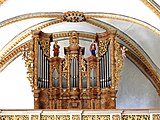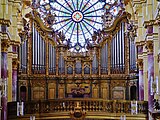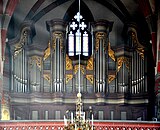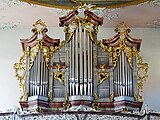Johann Philipp Seuffert
Johann Philipp Seuffert (born March 5, 1693 in Gössenheim an der Wern, † June 18, 1780 in Würzburg ) was a German organ builder and founder of an organ building family that built over 300 organs in three generations .
Life
Johann Philipp Seuffert learned his trade from the Würzburg court organ maker Johann Hoffmann . His traveling years from 1711 to 1721 took him to Austria , Hungary , Bohemia and possibly Poland to visit the masters of his field and study their work. After the death of the Würzburg organ builder Franz Karl Hillenbrand, he married his widow Anna Magdalena on March 16, 1722 and thus had his own workshop. On July 12, 1731, he was awarded the coveted title "Court Organ Maker of Würzburg". As a result he received numerous orders, e.g. B. for Banz Monastery in Upper Franconia , where an organ from him is still located today and many smaller orders, e.g. B. for the cemetery chapel in Gerolzhofen in the district of Schweinfurt .
In 1745 he built his largest organ with 36 registers in the Westphalian abbey of Grafschaft , divided into two manuals and a pedal. One of his works can be found in the parish church of Gaibach in the Kitzingen district, built by Balthasar Neumann . Seuffert built a total of around 200 new organs. Johann Ferdinand Balthasar Stieffell worked with him as a journeyman .
progeny
Johann Philipp's older son Johann Ignaz Seuffert first went to France as an organ builder and later settled in Offenburg . The youngest son Franz Ignaz Seuffert (1732–1810) joined his father's workshop and took over the office of court organ builder from 1760. A well-preserved copy of his numerous works can be found in the parish church of the Lower Franconian wine village of Obervolkach .
Franz Ignaz Seuffert's older son Johann Philipp Albert Seuffert (1763–1834) continued the office of court organ builder until 1834. An organ from him has been preserved in Neuses am Berg in the Kitzingen district. After his death, the Seuffert family's Würzburg workshop was temporarily orphaned until Balthasar Schlimbach took it over in 1836.
Franz Ignaz Seuffert's younger son Franz Martin Seuffert (1772–1847) went to Vienna as a piano maker in 1804 and opened a piano factory there, from which in 1855 the Friedrich Ehrbar piano factory emerged .
Works (selection)
The size of the instruments is indicated in the fifth column by the number of manuals and the number of sounding registers in the sixth column. A capital “P” stands for an independent pedal, a lowercase “p” for an attached pedal. Italicization indicates that the organ in question is no longer available or that only the brochure is from the workshop.
| year | place | building | image | Manuals | register | Remarks |
|---|---|---|---|---|---|---|
| 1723 | Laudenbach | Laudenbach mountain church |

|
I / P | 13 | Housing and a pedal register taken from Seuffert have been preserved |
| 1731 | Gerlachsheim | Holy Cross |

|
I / P | 16 | original disposition known |
| 1731 | Marktsteinach | St. Bartholomew | I / P | 11 | Housing and 8 registers preserved | |
| 1736 | Spoonsterz | St. Aegidius | I / P | 12 | Housing and 8 registers preserved | |
| 1738 | Fridritt | St. Lawrence and the Assumption |

|
I / P | 16 | Winter choir organ; rearranged in the 19th century, restored to original layout in 1975; Housing and 8 registers preserved |
| 1743 | Banz Monastery | Monastery church |

|
I / P | 8th | Winter choir organ; 1804 to Oberküps / St. Katharina sold, later changed; Mostly rebuilt in 1966 by Walcker during a restoration |
| 1743 | Ebrach | Banz Monastery |

|
II / P | 32 | Main organ; Reconstructed in 1902 and 1984; Housing and several registers preserved |
| 1743 | Gerolzhofen | Cemetery chapel | I. | |||
| 1746 | County (Schmallenberg) | Kloster Grafschaft , monastery church |

|
II / P | 35 | After the abolition of the monastery in 1811, it was transferred to Frankenberg (Eder) , where it was replaced by a Walcker organ with a new case in 1957, including some registers, the old registers were removed during an extension by Orgelbau Böttner in 1970 and stored by Gerald Woehl , who contributed them in 1984 his reconstruction of the Seuffert organ in Banz Monastery (photo) |
| 1748 | Gaibach | Trinity Church |

|
I / P | 12 | Housing and 9 registers preserved |
| around 1750 | Kirrweiler | Lady Chapel | I / p | 6th | as an interim organ for the parish church during the building of the new organ there, after its completion it was moved to the chapel; receive | |
| 1751 | Iphofen | St. Vitus |

|
I / P | 15? | 1861 by Augustin Bittner extensively rebuilt and expanded with two manuals (II / P / 16), 1986 Seuffert's disposition restored, but the second manual retained (II / P / 23) |
| 1752 | Einersheim market | St. Matthew |

|
III / P | 24 | Housing received |
| 1754 | Ochsenfurt | St. Andrew |

|
Housing received | ||
| 1756 | Münnerstadt | Augustinian monastery church | II / P | 26th | New building by Michael Weise (Plattling, 1935 II / P 26) in the historical prospect and renovation / renewal by Horst Hoffmann (1979) | |
| 1756 | Limbach | Pilgrimage church Maria Limbach | I / P | 16 | Largest preserved Seuffert organ, components and registers lost in 1986 reconstructed based on other Seuffert organs | |
| 1760 | Obereuerheim | St. Laurence | I / P | 11 | Existing largely preserved | |
| 1761 | Erlabrunn | St. Andrew | I / P | 12 | 1975 moved to St. Nikolaus (Überlingen) (Marien organ); Housing and register largely preserved |
literature
- Hermann Fischer , Theodor Wohnhaas : Lexicon of southern German organ builders . Florian Noetzel Verlag, Wilhelmshaven 1994, ISBN 3-7959-0598-2 , p. 385-387 .
- Hermann Fischer: The organ builder Johann Philipp Seuffert and his descendants in Würzburg, Kirrweiler and Vienna . Commission publisher Ferdinand Schöningh, Würzburg 2015, ISBN 978-3-87717-077-9 , p. 31-55 .
- Rudolf Walter: The organ building style by Joh. Philipp Seuffert (1693–1780). In: Acta Organologica . Vol. 20, Kassel 1988, pp. 113-148.
Web links
- Literature by and about Johann Philipp Seuffert in the catalog of the German National Library
- Hermann Fischer: Seuffert organ builder . In: German biography . Vol. 24, 2010, pp. 278-279.
- Melanie Jäger-Waldau: The 250-year-old Johann-Philipp-Seuffert organ in the Überlinger Münster. (PDF; 589 kB). In: Ars Organi . 60/1. 2012, pp. 43–47.
Individual evidence
- ↑ Melanie Jäger-Waldau : The 250-year-old Johann-Philipp-Seuffert organ in the Überlinger Münster. (PDF; 589 kB). In: Ars Organi . 60/1. 2012, p. 43.
- ^ Marienorgel in Überlingen , accessed on June 4, 2017.
| personal data | |
|---|---|
| SURNAME | Seuffert, Johann Philipp |
| BRIEF DESCRIPTION | German organ builder and founder of an organ building family |
| DATE OF BIRTH | March 5, 1693 |
| PLACE OF BIRTH | Gössenheim an der Wern |
| DATE OF DEATH | June 18, 1780 |
| Place of death | Wurzburg |


